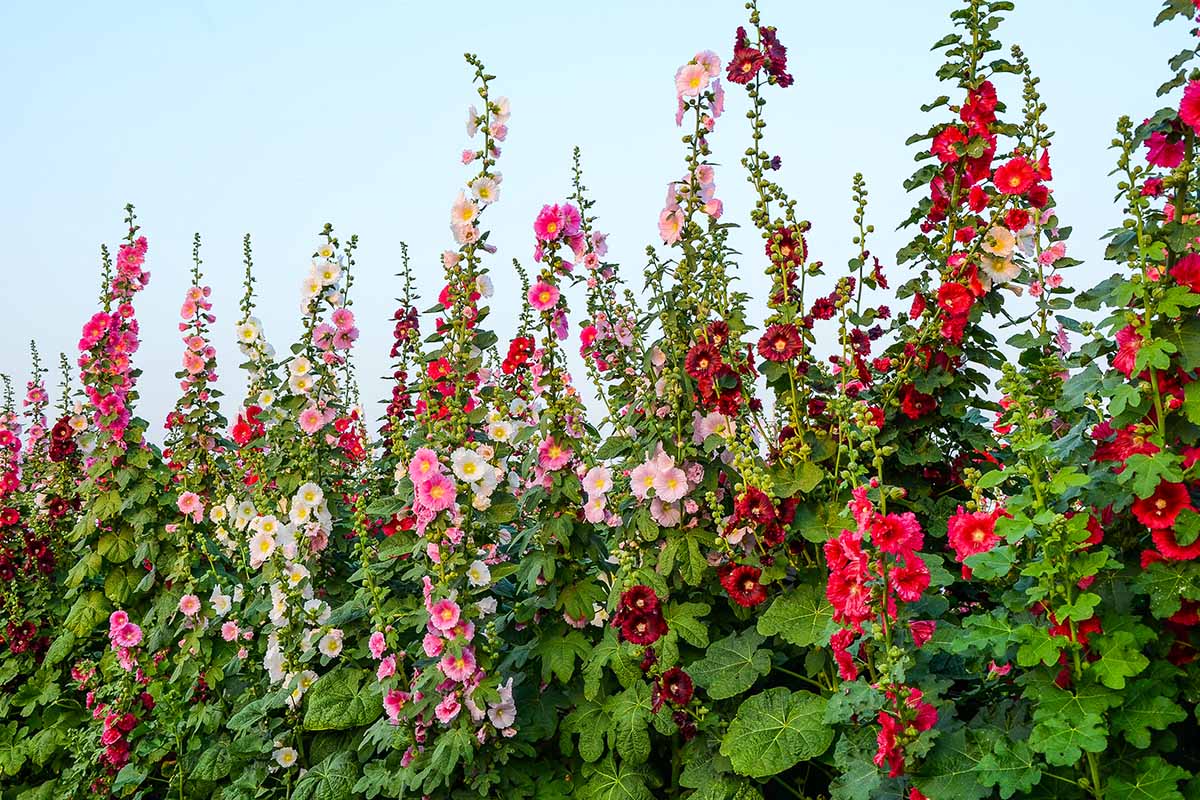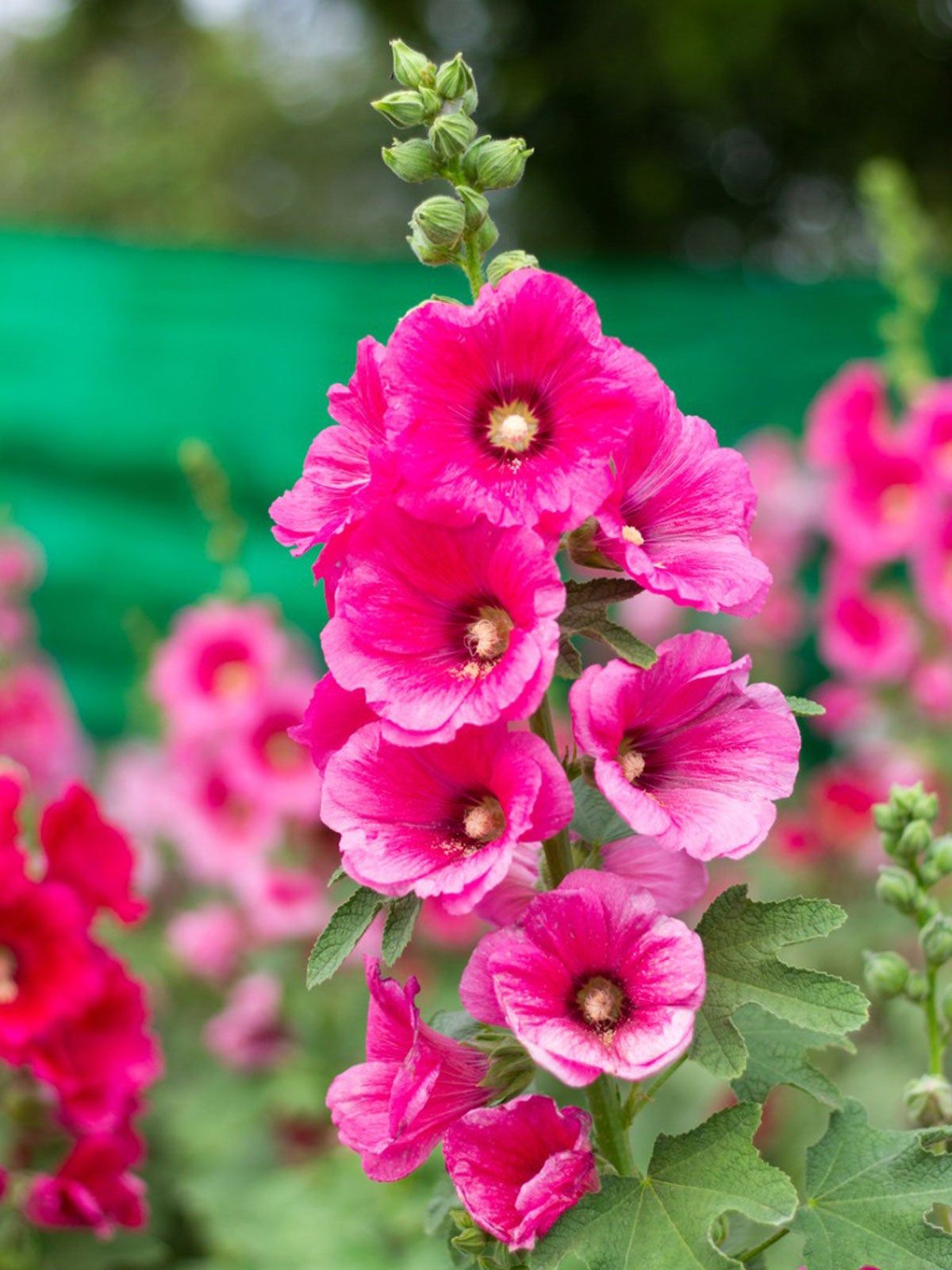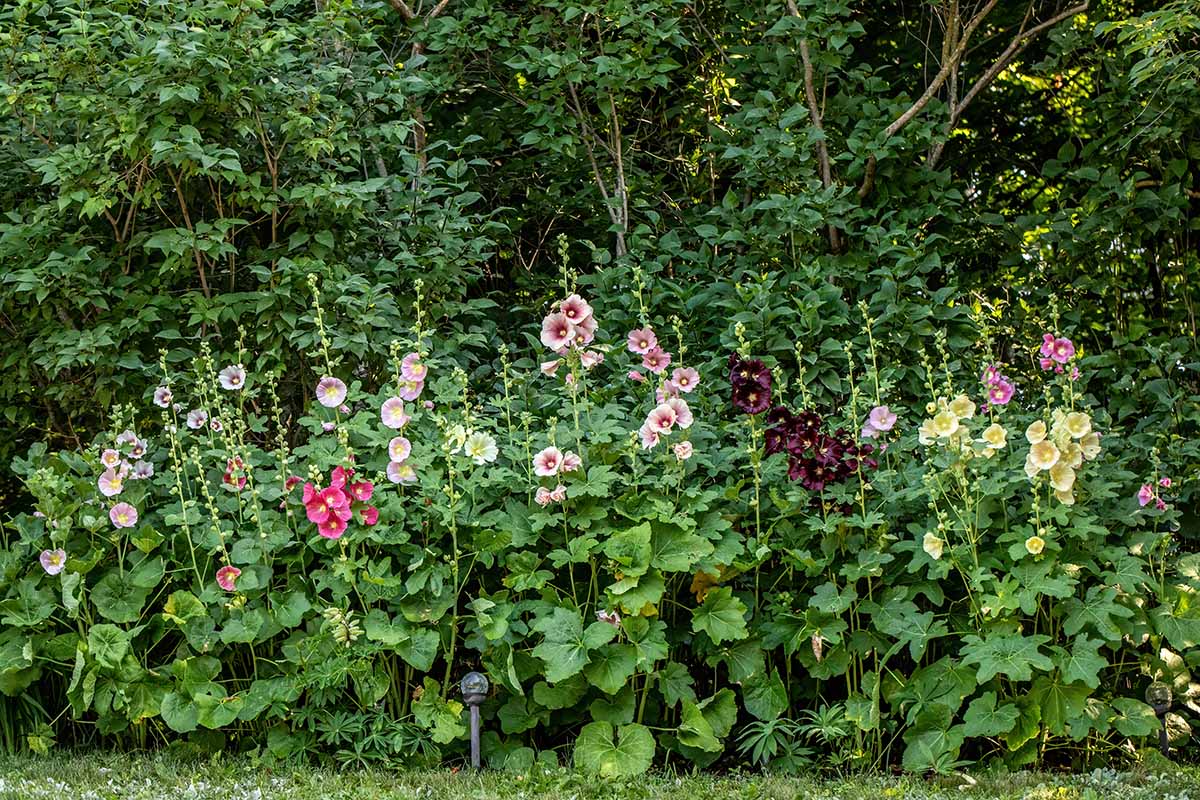Choosing the Right Conditions for Hollyhock Success
When it comes to growing hollyhock plants, selecting the right conditions is crucial for optimal growth and blooming. Hollyhocks require full sun to partial shade, with a minimum of 6 hours of direct sunlight per day. This will ensure that the plants receive the necessary energy to produce tall, stately blooms. In addition to sunlight, hollyhocks also require well-draining soil to prevent waterlogged soil conditions that can lead to root rot.
To assess your garden’s conditions, start by evaluating the amount of sunlight your garden receives. If your garden receives full sun, consider providing some afternoon shade to prevent scorching of the leaves. Next, evaluate your soil’s drainage by digging a small test hole and filling it with water. If the water drains quickly, your soil is well-draining. If not, consider adding organic matter such as compost or well-rotted manure to improve soil structure.
Another important factor to consider is soil pH. Hollyhocks prefer a slightly acidic to neutral soil pH, ranging from 6.0 to 7.0. If your soil pH is too high or too low, it can affect nutrient availability and plant growth. To adjust your soil pH, add lime to raise the pH or sulfur to lower it.
By selecting the right conditions for your hollyhock plants, you’ll be well on your way to growing tall, stately blooms that will add beauty and elegance to your garden. Remember to also choose a location with good air circulation to prevent disease and promote healthy growth.
For those looking to learn how to grow hollyhock plants, it’s essential to understand the importance of providing the right conditions. By following these tips, you’ll be able to create an environment that fosters healthy growth and blooming. Whether you’re a seasoned gardener or just starting out, growing hollyhocks can be a rewarding experience that brings joy and beauty to your garden.
Preparing the Soil for Hollyhock Planting
Before planting hollyhocks, it’s essential to prepare the soil to provide the best possible growing conditions. Hollyhocks prefer well-draining, fertile soil that is rich in organic matter. To achieve this, start by removing any debris, rocks, or weeds from the planting area. This will ensure that the soil is clear of any obstacles that could hinder root growth or plant development.
Next, add organic matter such as compost or well-rotted manure to the soil. This will help to improve soil fertility, structure, and overall health. Compost or well-rotted manure can be incorporated into the soil at a rate of 2-4 inches per 6-8 inches of soil depth. This will provide a nutrient-rich environment for the hollyhocks to grow and thrive.
In addition to adding organic matter, it’s also important to adjust the soil pH if necessary. Hollyhocks prefer a slightly acidic to neutral soil pH, ranging from 6.0 to 7.0. If the soil pH is too high or too low, it can affect nutrient availability and plant growth. To adjust the soil pH, add lime to raise the pH or sulfur to lower it.
For those looking to learn how to grow hollyhock plants, preparing the soil is a critical step in the process. By adding organic matter and adjusting the soil pH, you can create a fertile and well-draining environment that will support healthy growth and blooming. Remember to also consider the specific soil needs of your hollyhock variety, as some may require more or less organic matter or pH adjustments.
By taking the time to prepare the soil properly, you’ll be rewarded with tall, stately blooms that will add beauty and elegance to your garden. Whether you’re a seasoned gardener or just starting out, growing hollyhocks can be a rewarding experience that brings joy and beauty to your outdoor space.
Obtaining Healthy Hollyhock Plants or Seeds
When it comes to growing hollyhocks, obtaining healthy plants or seeds is crucial for success. There are several options for obtaining hollyhock plants or seeds, including purchasing from reputable nurseries or online suppliers, or saving seeds from mature plants.
Purchasing from reputable nurseries or online suppliers is a great way to ensure that you are getting healthy, disease-free plants or seeds. Look for suppliers that specialize in hollyhocks and have a good reputation for providing high-quality plants or seeds. When purchasing online, make sure to read reviews and check the supplier’s ratings before making a purchase.
Another option for obtaining hollyhock plants or seeds is to save seeds from mature plants. This can be a cost-effective and rewarding way to propagate new hollyhocks. To save seeds, simply allow the flowers to go to seed and then harvest the seeds when they are mature. Make sure to store the seeds in a cool, dry place until you are ready to plant them.
Regardless of where you obtain your hollyhock plants or seeds, it’s essential to select disease-free plants or seeds. Look for plants or seeds that are free of pests and diseases, and make sure to inspect them carefully before planting. By selecting healthy plants or seeds, you can help ensure that your hollyhocks will thrive and produce beautiful blooms.
For those looking to learn how to grow hollyhock plants, obtaining healthy plants or seeds is a critical step in the process. By selecting disease-free plants or seeds, you can help ensure that your hollyhocks will grow and thrive, producing beautiful blooms for years to come. Whether you’re a seasoned gardener or just starting out, growing hollyhocks can be a rewarding experience that brings joy and beauty to your garden.
When selecting hollyhock plants or seeds, make sure to choose varieties that are suitable for your climate and growing conditions. Some hollyhock varieties are more tolerant of heat or cold than others, so make sure to choose varieties that are well-suited to your area. By selecting the right variety, you can help ensure that your hollyhocks will thrive and produce beautiful blooms.
Planting Hollyhocks: A Step-by-Step Guide
Planting hollyhocks is a relatively straightforward process, but it does require some care and attention to detail. To ensure that your hollyhocks get off to a strong start, follow these step-by-step instructions:
Step 1: Prepare the Planting Site
Before planting your hollyhocks, make sure the soil is well-draining and has been prepared with organic matter such as compost or well-rotted manure. If your soil is heavy clay or sandy, mix in some organic matter to improve its structure.
Step 2: Plant the Hollyhocks
Plant your hollyhocks in the spring or fall, when the weather is cooler. Dig a hole that is twice as wide and just as deep as the root ball of the plant. Gently remove the plant from its container and place it in the hole. Fill in the hole with soil, making sure to firm it gently around the roots.
Step 3: Water the Hollyhocks
Water your hollyhocks thoroughly after planting, and continue to keep the soil consistently moist during the first growing season. Avoid overwatering, which can lead to root rot and other problems.
Step 4: Space the Hollyhocks Correctly
Space your hollyhocks 12-18 inches apart, depending on the variety. This will give them room to grow and prevent overcrowding, which can lead to disease and pest problems.
For those looking to learn how to grow hollyhock plants, planting is a critical step in the process. By following these step-by-step instructions, you can ensure that your hollyhocks get off to a strong start and thrive in their new home. Whether you’re a seasoned gardener or just starting out, growing hollyhocks can be a rewarding experience that brings joy and beauty to your garden.
When planting hollyhocks, it’s also important to handle the roots with care. Hollyhock roots are sensitive and can be easily damaged, so make sure to handle them gently when planting. Avoid exposing the roots to air for too long, and make sure to plant them at the same depth as they were in the container.
Supporting Tall Hollyhock Stems: Staking and Pruning
As hollyhock plants grow, they can reach impressive heights of up to 9 feet, making them a stunning addition to any garden. However, their tall stems can be prone to wind damage, which can cause the plants to become dislodged or even break. To prevent this, staking is essential. Staking provides support to the stems, keeping them upright and secure, and ensuring that the plants can continue to grow and thrive.
To stake hollyhock stems, use bamboo stakes or wooden dowels that are at least 6 feet tall. Drive the stakes into the ground about 12 inches from the base of the plant, and tie the stem to the stake using twine or a soft material. Make sure the tie is not too tight, as this can damage the stem. It’s also a good idea to stake the plants when they are still young, as this will help prevent wind damage and promote healthy growth.
In addition to staking, pruning is also an essential part of hollyhock care. Pruning helps to promote healthy growth, encourages blooming, and maintains the shape of the plant. To prune hollyhocks, remove any dead or damaged leaves or stems, and cut back the plant
Supporting Tall Hollyhock Stems: Staking and Pruning
As hollyhock plants grow, they can reach impressive heights of up to 9 feet, making them a stunning addition to any garden. However, their tall stems can be prone to wind damage, which can cause the plants to become dislodged or even break. To prevent this, staking is essential. Staking provides support to the stems, keeping them upright and secure, and ensuring that the plants can continue to grow and thrive.
To stake hollyhock stems, use bamboo stakes or wooden dowels that are at least 6 feet tall. Drive the stakes into the ground about 12 inches from the base of the plant, and tie the stem to the stake using twine or a soft material. Make sure the tie is not too tight, as this can damage the stem. It’s also a good idea to stake the plants when they are still young, as this will help prevent wind damage and promote healthy growth.
In addition to staking, pruning is also an essential part of hollyhock care. Pruning helps to promote healthy growth, encourages blooming, and maintains the shape of the plant. To prune hollyhocks, remove any dead or damaged leaves or stems, and cut back the plant to about one-third of its height after it has finished blooming. This will help the plant conserve energy and promote new growth.
Pruning also helps to control the height of the plant, which can be beneficial if you have limited space in your garden. By pruning the plant regularly, you can keep it at a manageable height and encourage it to produce more blooms. It’s also a good idea to remove any seed heads that form after the plant has finished blooming, as this will help promote new growth and prevent the plant from putting its energy into seed production.
When pruning hollyhocks, make sure to use clean and sharp tools to prevent spreading diseases. It’s also a good idea to prune the plant in the morning, when the dew is still on the leaves, as this will help prevent the spread of diseases. By staking and pruning your hollyhock plants regularly, you can help them grow tall and strong, and enjoy their beautiful blooms for years to
Supporting Tall Hollyhock Stems: Staking and Pruning
As hollyhock plants grow, they can reach impressive heights of up to 9 feet, making them a stunning addition to any garden. However, their tall stems can be prone to wind damage, which can cause the plants to become dislodged or even break. To prevent this, staking is essential. Staking provides support to the stems, keeping them upright and secure, and ensuring that the plants can continue to grow and thrive.
To stake hollyhock stems, use bamboo stakes or wooden dowels that are at least 6 feet tall. Drive the stakes into the ground about 12 inches from the base of the plant, and tie the stem to the stake using twine or a soft material. Make sure the tie is not too tight, as this can damage the stem. It’s also a good idea to stake the plants when they are still young, as this will help prevent wind damage and promote healthy growth.
In addition to staking, pruning is also an essential part of hollyhock care. Pruning helps to promote healthy growth, encourages blooming, and maintains the shape of the plant. To prune hollyhocks, remove any dead or damaged leaves or stems, and cut back the plant to about one-third of its height after it has finished blooming. This will help the plant conserve energy and promote new growth.
Pruning also helps to control the height of the plant, which can be beneficial if you have limited space in your garden. By pruning the plant regularly, you can keep it at a manageable height and encourage it to produce more blooms. It’s also a good idea to remove any seed heads that form after the plant has finished blooming, as this will help promote new growth and prevent the plant from putting its energy into seed production.
When pruning hollyhocks, make sure to use clean and sharp tools to prevent spreading diseases. It’s also a good idea to prune the plant in the morning, when the dew is still on the leaves, as this will help prevent the spread of diseases. By staking and pruning your hollyhock plants regularly, you can help them grow tall and strong, and enjoy their beautiful blooms for years to
Supporting Tall Hollyhock Stems: Staking and Pruning
As hollyhock plants grow, they can reach impressive heights of up to 9 feet, making them a stunning addition to any garden. However, their tall stems can be prone to wind damage, which can cause the plants to become dislodged or even break. To prevent this, staking is essential. Staking provides support to the stems, keeping them upright and secure, and ensuring that the plants can continue to grow and thrive.
To stake hollyhock stems, use bamboo stakes or wooden dowels that are at least 6 feet tall. Drive the stakes into the ground about 12 inches from the base of the plant, and tie the stem to the stake using twine or a soft material. Make sure the tie is not too tight, as this can damage the stem. It’s also a good idea to stake the plants when they are still young, as this will help prevent wind damage and promote healthy growth.
In addition to staking, pruning is also an essential part of hollyhock care. Pruning helps to promote healthy growth, encourages blooming, and maintains the shape of the plant. To prune hollyhocks, remove any dead or damaged leaves or stems, and cut back the plant to about one-third of its height after it has finished blooming. This will help the plant conserve energy and promote new growth.
Pruning also helps to control the height of the plant, which can be beneficial if you have limited space in your garden. By pruning the plant regularly, you can keep it at a manageable height and encourage it to produce more blooms. It’s also a good idea to remove any seed heads that form after the plant has finished blooming, as this will help promote new growth and prevent the plant from putting its energy into seed production.
When pruning hollyhocks, make sure to use clean and sharp tools to prevent spreading diseases. It’s also a good idea to prune the plant in the morning, when the dew is still on the leaves, as this will help prevent the spread of diseases. By staking and pruning your hollyhock plants regularly, you can help them grow tall and strong, and enjoy their beautiful blooms for years to









